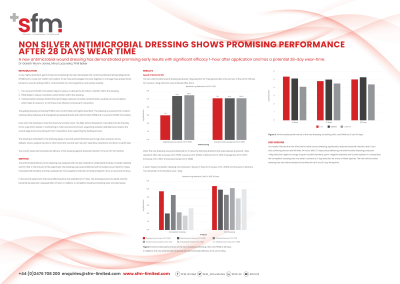Laboratory Research
(LR-055) A new, non-silver wound dressing has demonstrated promising early results with significant antimicrobial efficacy 1-hour after application and has a potential 28-day wear-time.
Friday, April 28, 2023
7:15 PM - 8:30 PM East Coast USA Time

Graeme Kettlewell, PhD – Director of Research and Development, R&D, Speciality Fibres and Materials Ltd
Introduction: A new, non-silver, cellulose-based wound dressing has demonstrated to significantly reduce bacteria within 1-hour and could potentially be worn for 28-days. It is coated with a novel antimicrobial formulation containing PHMB (polyhexanide).
Methods: Antimicrobial efficacy of the dressing was assessed with the test method for antibacterial finishes on textile materials (AATCC 100). In the first part of the experiment, the dressings were preconditioned with simulated wound fluid for 6-days, inoculated with bacteria then assessed for microorganism reduction at three timepoints 1 hour, 4 hours and 24 hours.
In the second experiment, the preconditioning time was extended to 27-days. The dressings were then inoculated, and the bacterial log reduction assessed after 24 hours. In addition, a competitor dressing containing silver was also tested.
Results: The new, non-silver dressing produced >4log reduction for P.aeruginosa after only one hour in the AATCC 100 test. For S.aureus >4log reduction was achieved after 4hour.
When the new dressing was preconditioned for 27-days the following bacteria and yeast species produced >4log reduction after 24h; S.aureus ATCC 6538, S.aureus ATCC 43300, C.albicans ATCC 10231, P.aeruginosa ATCC 9027, E.cloacae ATCC 13047 and K.pneumoniea ATCC 13883.
A silver-based competitor dressing only achieved >4log at 27-days for S.aureus ATCC 43300 and the yeast C.albicans. The remainder of the bacteria were < 4log.
Discussion: The results indicate the new, non-silver wound dressing significantly reduced bacterial infection after 1 hour achieving almost total kill after 24 hours. With 27-days preconditioning, the SFM dressing produced >4log reduction against a range of gram-positive bacteria, gram-negative bacteria and a yeast species. In comparison, the competitor dressing was only able to achieve a 2-log reduction for many of these species.
Methods: Antimicrobial efficacy of the dressing was assessed with the test method for antibacterial finishes on textile materials (AATCC 100). In the first part of the experiment, the dressings were preconditioned with simulated wound fluid for 6-days, inoculated with bacteria then assessed for microorganism reduction at three timepoints 1 hour, 4 hours and 24 hours.
In the second experiment, the preconditioning time was extended to 27-days. The dressings were then inoculated, and the bacterial log reduction assessed after 24 hours. In addition, a competitor dressing containing silver was also tested.
Results: The new, non-silver dressing produced >4log reduction for P.aeruginosa after only one hour in the AATCC 100 test. For S.aureus >4log reduction was achieved after 4hour.
When the new dressing was preconditioned for 27-days the following bacteria and yeast species produced >4log reduction after 24h; S.aureus ATCC 6538, S.aureus ATCC 43300, C.albicans ATCC 10231, P.aeruginosa ATCC 9027, E.cloacae ATCC 13047 and K.pneumoniea ATCC 13883.
A silver-based competitor dressing only achieved >4log at 27-days for S.aureus ATCC 43300 and the yeast C.albicans. The remainder of the bacteria were < 4log.
Discussion: The results indicate the new, non-silver wound dressing significantly reduced bacterial infection after 1 hour achieving almost total kill after 24 hours. With 27-days preconditioning, the SFM dressing produced >4log reduction against a range of gram-positive bacteria, gram-negative bacteria and a yeast species. In comparison, the competitor dressing was only able to achieve a 2-log reduction for many of these species.

.png)